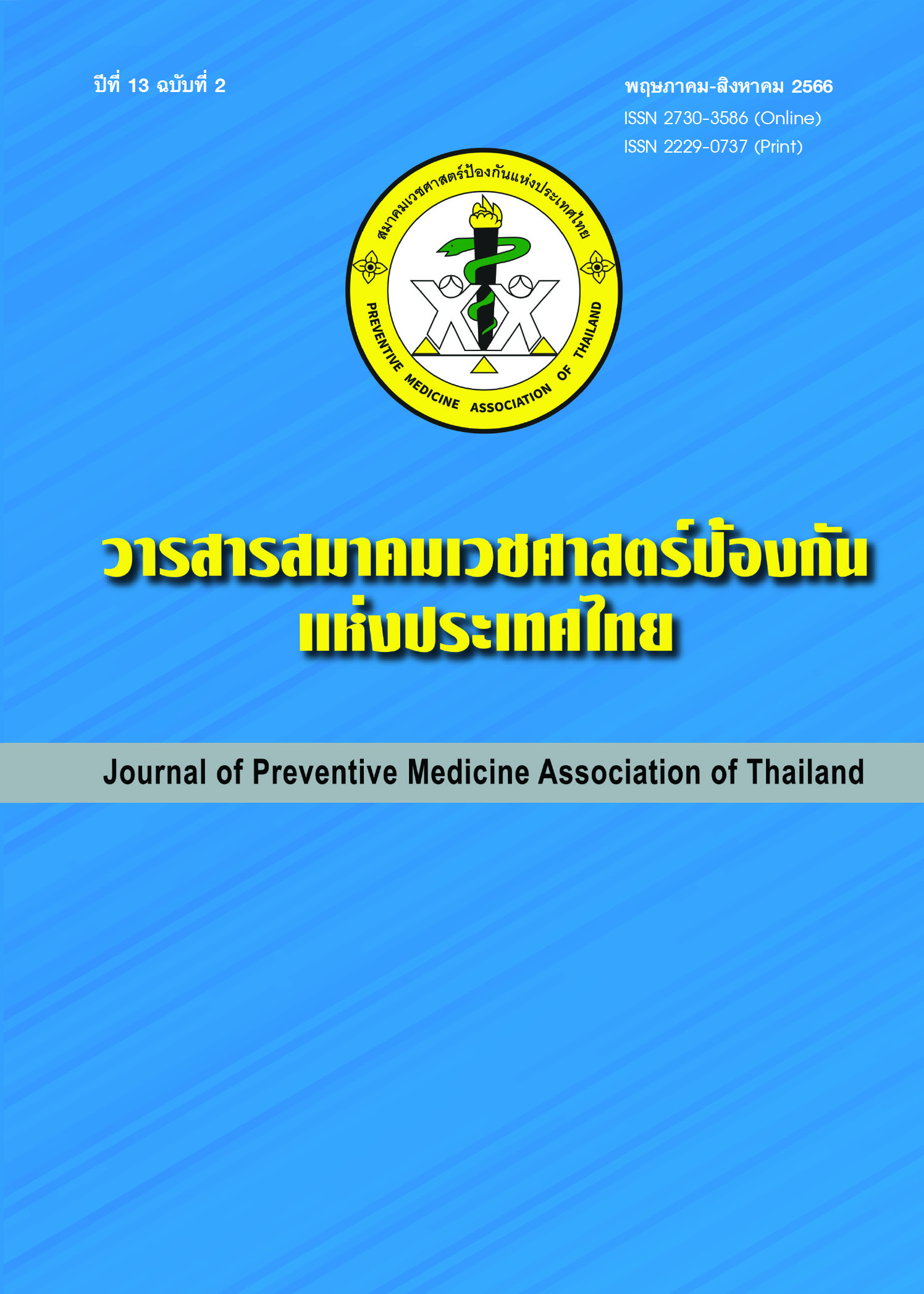The Comparative Study of Domestic Violence among Patients in One Stop Crisis Center (OSCC) Before and During COVID-19 Pandemic, Lampang Hospital
Keywords:
COVID-19, domestic violence, emergency levelAbstract
Introduction: Due to lockdown measurement as a result of COVID-19 pandemic, people were forced to self-quarantine at home for a long time which increased stress level among people. Furthermore, self-quarantine also increased a longer periods of time that victims and abusers were together. Therefore, the risk of domestic violence had increased. However, there is lack of information about domestic violence during COVID-19 pandemic in Lampang province. Objective: The aim of this study was to compare the type of domestic violences and emergency level in patients of OSCC, Lampang hospital before and during COVID-19 pandemic. Method: A descriptive study was conducted using medical records from OSCC at Lampang hospital before and during COVID-19 pandemic. Results: A total number of 747 domestic violence cases were identified with 389 cases before COVID-19 and 358 cases during COVID-19. Most of the cases were female both before and during COVID-19 (87.7% and 82.1%). Physical violence was found to be the most common type of domestic violences with 76.6% before COVID-19 and 81% during COVID-19. The emergency level of the cases which divided by first three level of triage (level I – III) during COVID-19 (63.7%) was higher than before COVID-19 (45.2%). Conclusion: The study found that although there were fewer domestic violence cases during COVID-19 than the time before COVID-19, but the emergency level of the cases was significantly higher.
References
Open Development Thailand. โควิด 19 (COVID-19) ในประเทศไทย [อินเทอร์เน็ต] 2564. [เข้าถึงเมื่อ 17 ต.ค.2564] เข้าถึงได้จาก: https://thailand.opendevelopmentmekong.net/th/topics/pandemics-covid-19/
Goh KK, Lu ML, Jou S. Impact of COVID-19 pandemic: social distancing and the vulnerability to domestic violence. Psychiatry Clin Neurosci 2020;74(11):612-13.
Peraud W, Quintard B, Constant A. Factors associated with violence against women following the COVID-19 lockdown in France: Results from a prospective online survey. PLoS One 2021;16(9):e0257193.
Rodriguez L. Domestic Violence Increased in the US by 8.1% During the COVID-19 Pandemic [Internet]. 2021 [cited 2021 Oct 17]. Available from: https://www.globalcitizen.org/en/content/domestic-violence-covid-19-increase-us-ncccj-study/
Gama A , Pedro AR, de Carvalho MJL, Guerreiro AE, Duarte V, Quintas J, et al. Domestic violence during the COVID-19 pandemic in Portugal. Port J Public Health 2021;38(Suppl.1):32-40.
Leslie E, Wilson R. Sheltering in place and domestic violence: evidence from calls for service during COVID-19. J Public Econ 2020;189:104241.
Maji S, Bansod S, Singh T. Domestic violence during COVID-19 pandemic: the case for Indian women. J Community Appl Soc Psychol 2021;32(3):374-81.
กรมสุขภาพจิต. จะทำอย่างไร เมื่อความรุนแรงไม่ใช่เรื่องไกลตัวและบ้านไม่ใช่ Safe Zone ของทุกคน [อินเทอร์เน็ต]. 2564 [เข้าถึงเมื่อ 17 ต.ค.2564] เข้าถึงได้จาก: https://www.dmh.go.th/news-dmh/view.asp?id=30715
สำนักข่าวไทย. สถิติความรุนแรงในครอบครัว ช่วงโควิดพุ่งสูงเฉลี่ย 200 เรื่อง/เดือน [อินเทอร์เน็ต]. 2564 [เข้าถึงเมื่อ 4 ธ.ค. 2564] เข้าถึงได้จาก: https://tna.mcot.net/social-808024
กรมกิจการสตรีและสถาบันครอบครัว. นิยามและประเภทครอบครัว [อินเทอร์เน็ต]. 2562 [เข้าถึงเมื่อ 26 พ.ย. 2565] เข้าถึงได้จาก: http://intranet.dop.go.th/intranet_older/fls/fls_uploads/52747/นิยามและประเภทครอบครัว.pdf
ชลาศัย กันมินทร์. ความรุนแรงในครอบครัว: ปัญหาและแนวทางป้องกัน [อินเทอร์เน็ต]. 2562 [เข้าถึงเมื่อ 17 ต.ค. 2564] เข้าถึงได้จาก: https://rsucon.rsu.ac.th/files/proceedings/nation2019/NA19-136.pdf
ศรัณย์ คัมภิรานนท์. ความรุนแรงในครอบครัวของสังคมไทย (Domestic Violence in Thai Society) [อินเทอร์เน็ต]. 2563 [เข้าถึงเมื่อ 17 ต.ค. 2564] เข้าถึงได้จาก: https://www.senate.go.th/document/Ext23112/23112774_0002.PDF
โรงพยาบาลระนอง. ศูนย์บริการช่วยเหลือเด็กและสตรีที่ถูกกระทำรุนแรง (One Stop Crisis Center, OSCC) หรือ “ศูนย์พึ่งได้”: บทบาทหน้าที่ของศูนย์พึ่งได้.[อินเทอร์เน็ต]. 2559 [เข้าถึงเมื่อ 30 พ.ย.2565] เข้าถึงได้จาก: https://www.rnh.go.th/main/index.php/oscc
สุไรยา รามาน, นุสรา ศรีศรัยมณี, ชนากานต์ เกิดกลิ่นหอม. TRIAGE [อินเทอร์เน็ต]. 2565 [เข้าถึงเมื่อ 26 พ.ย.2565]. เข้าถึงได้จาก: https://www.si.mahidol.ac.th/Th/division/nursing/NDivision/N_OBS/admin/knowledges_files/31_65_1.pdf
Downloads
Published
How to Cite
Issue
Section
License
Copyright (c) 2023 Journal of Preventive Medicine Association of Thailand

This work is licensed under a Creative Commons Attribution-NonCommercial-NoDerivatives 4.0 International License.
บทความที่ลงพิมพ์ในวารสารเวชศาสตร์ป้องกันแห่งประเทศไทย ถือเป็นผลงานวิชาการ งานวิจัย วิเคราะห์ วิจารณ์ เป็นความเห็นส่วนตัวของผู้นิพนธ์ กองบรรณาธิการไม่จำเป็นต้องเห็นด้วยเสมอไปและผู้นิพนธ์จะต้องรับผิดชอบต่อบทความของตนเอง






